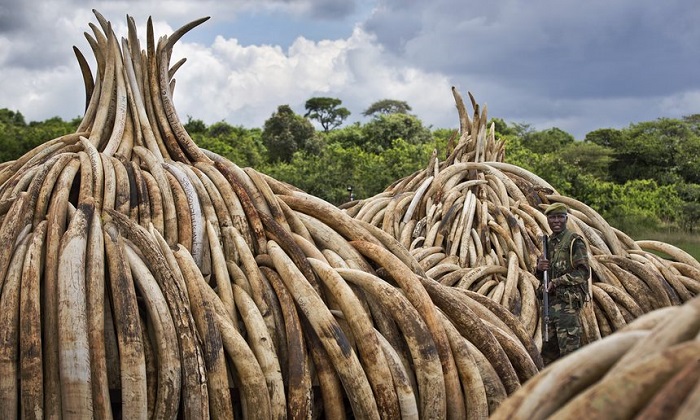On Friday, Kenyatta said Kenya would seek a “total ban on the trade in elephant ivory” at an international wildlife trade meeting in South Africa this September. “The future of the African elephant and rhino is far from secure so long as demand for their products continues to exist,” he said.
On Saturday about 105 tonnes of elephant ivory and 1.5 tonnes of rhino horn will burn in 11 large pyres, about seven times the amount previously burned in a single event. The bonfire, so big it will take about four hours to burn completely, highlights the continuing crisis in elephant populations. About 30,000 to 50,000 elephants a year were killed from 2008 to 2013 alone, according to the Born Free Foundation, and the rate of killing is outstripping the rate of births in Africa.
Prior to the burning, as much scientific and educational information as possible has been extracted, and Kenya will be left with about 20 tonnes of ivory that are still going through the legal process.
Ronnie Wood, the Rolling Stone and patron of the Tusk charity, was among celebrities speaking out ahead of the burn: “It makes me so sad to think that in another 15 years or so elephants, rhinos and even lions could have disappeared from the wild, denying our children the experience of knowing and loving them. We just cannot allow that to happen.”
Kenya first burned ivory in 1989, under president Daniel Arap Moi, as a symbol of its determination to protect its remaining elephant population, which had fallen 90% in the previous 15 years, from 168,000 to 15,000 elephants.
Four countries – Kenya, Gabon, Uganda and Botswana – have among them more than half of Africa’s remaining elephants. The presidents will meet ahead of the burning to discuss new ways of preventing poaching, including a call to close down the world’s remaining legal ivory markets, at the conference of the Convention on International Trade in Endangered Species (Cites), in Johannesburg this September.
Iain Douglas-Hamilton, founder of Save the Elephants, said that cooperation among African countries was essential. “This [meeting] gives hope that there is political will to take on the challenges of poaching, trafficking, and high-level corruption that threaten the continent’s natural heritage.”
Burning seized ivory is a highly public symbol of the fight to save the elephant from extinction. Burning or crushing puts the ivory beyond use, preventing it from fuelling the world’s ivory markets, legal and illegal, as a way of stamping out that trade. More than a dozen countries have held similar public destructions of endangered animal products, including Malaysia, Hong Kong and the United Arab Emirates.
Some countries have tried allowing limited exploitation, for hunting and trophies, of their remaining “charismatic megafauna” as a method of conservation. Last year, the limited permitted hunting of big game was brought to global attention when the lion Cecil was shot, sparking widespread outrage and a ban on lion trophy imports by France which was joined by the Netherlands banning them on Friday.
In 2008, the ban on ivory was temporarily lifted to allow stockpiles to be sold to the profit of the countries that owned them. But according to campaigners this resulted in a “spike” in poaching, with about 100,000 elephants lost as a result.
This approach should be abandoned, according to a wide range of NGOs. “All experiments to permit a legal, controlled trade in ivory have failed,” said Daniela Freyer, co-founder of Pro Wildlife. “We can turn the tide if we close the legal markets that enable laundering of ivory from poached elephants or leaked from stockpiles.”
Other methods of discouraging poaching, such as removing tusks and dyeing rhino horns, have been tried to limited effect. Poaching has been fuelled by conflict, as well as organised crime, in many parts of Africa, where militias have used their arms, helicopters and jeeps to wage war on the wardens of conservation areas and on local populations.
Campaigners are also clear on the need for buyers of ivory to be targeted in campaigns to stop the trade. Ivory, rhino horn and other parts of endangered animals, including tiger skins, are sometimes use in Chinese medicine, but potentially a bigger problem is their use in high-status gifts in some Asian countries.
China officially disapproves of such gifts, and there have been moves to discourage and close down domestic markets, but widespread trade continues and it is not known when China’s pledges to stop it will be fulfilled.
“Ending the demand is absolutely key, but we don’t know how long this will take,” said Max Graham, chief executive of Kenyan charity Space for Giants. “We are already losing tens of thousands of elephants a year from a population of perhaps less than 400,000, and we desperately need a holding position.”
He called for “robust frontline protection, investment to reduce the cost and increase the benefits to local people of conserving elephants, and global efforts to cut demand for ivory”.
More about:















































